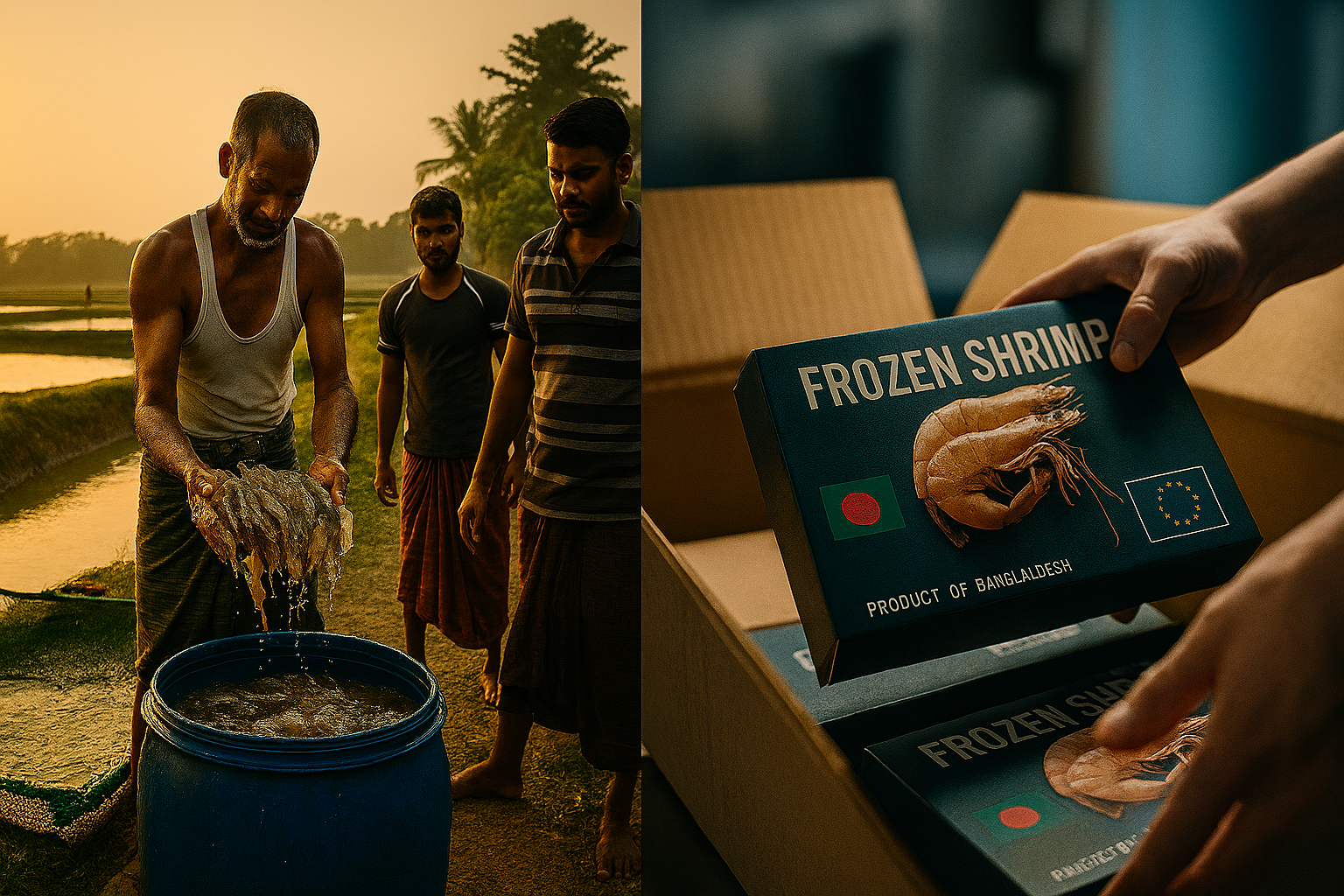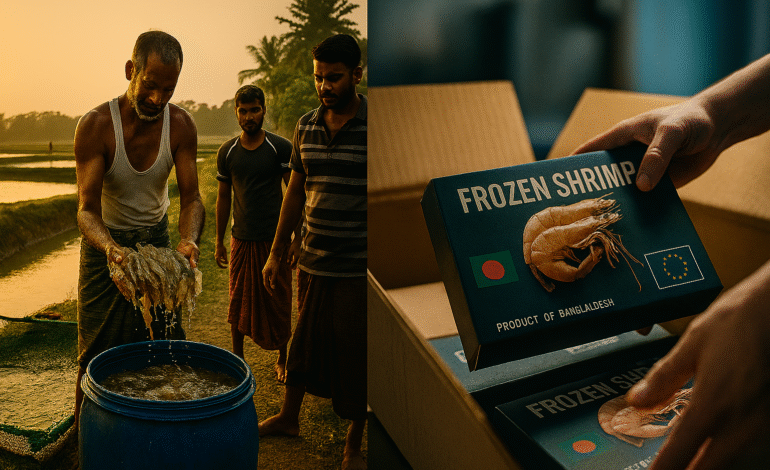Khulna’s Shrimp Industry: What Bangladesh’s Coastal Revival Means for Global Seafood Markets
Bangladesh’s shrimp sector, once considered the country’s “white gold,” is showing signs of a significant revival after years of decline. Nowhere is this resurgence more visible than in Khulna, the coastal region long known as the heart of Bangladesh’s shrimp and prawn production. The recent rebound in export volumes, improved access to premium markets, and renewed enthusiasm among farmers point to a potential turning point for the industry.
As Bangladesh repositions itself in the global seafood market, Khulna’s revival is more than a regional success story. It could reshape the country’s export strategy, strengthen coastal livelihoods, and help Bangladesh compete with global shrimp exporters such as Vietnam, India, and Ecuador.
A Sector Once in Decline Is Finding New Momentum
For more than a decade, Bangladesh’s shrimp industry struggled due to fluctuating global prices, disease outbreaks, supply chain disruptions, and falling production. Many of Khulna’s processing factories were forced to shut their doors, and farmers reduced or abandoned shrimp cultivation in favor of more stable seasonal crops.
But the tide is turning.
Recent reports show that shrimp exports from Khulna are rising again, supported by better farming practices, renewed international demand, and strategic government and private-sector initiatives. Exporters are observing stronger orders from Europe, the United States, and Japan, driven by the increasing global appetite for sustainably sourced shrimp.
Why Khulna Still Matters in the Global Shrimp Market
Khulna remains Bangladesh’s most strategic shrimp-producing hub for several reasons:
1. Ideal coastal ecology
Its brackish-water environment is naturally suited for Black Tiger (Penaeus monodon) shrimp, which still carries a premium price globally.
2. Large processing capacity
Despite recent closures, Khulna retains the country’s highest concentration of shrimp processing facilities, offering the infrastructure required for large-scale exports.
3. Skilled local workforce
Generations of families in Khulna have been engaged in shrimp farming, developing unique expertise in cultivation, harvesting, and manual processing.
These advantages position Khulna as a competitive player in the recovery of Bangladesh’s seafood exports.
The Role of Modernisation: Better Hygiene, Better Yields
A key driver of the revival is the industry’s gradual shift toward modern, hygienic, and standardized processing methods. Improved training programs, better water management, and stricter oversight are helping farmers produce shrimp that meet international standards.
Initiatives include:
- Farmer training on disease prevention
- Wholesale adoption of Good Aquaculture Practices (GAP)
- Upgraded hatcheries producing higher-quality fry
- Improved traceability systems for export certification
Such improvements have enabled Khulna shrimp to compete with international products in terms of safety, quality, and sustainability.
A Boost from Export Diversification
The rebound is also supported by Bangladesh’s efforts to diversify beyond conventional frozen shrimp. Exporters are exploring:
- Value-added shrimp products (breaded, cooked, peeled)
- Ready-to-cook packaged shrimp
- Premium Black Tiger shrimp for gourmet markets
Countries like Belgium, the Netherlands, and Germany, traditionally cautious markets with strict regulations have recently increased their orders, signaling renewed trust in the product quality coming out of Khulna’s processing plants.
Global Context: Competing in a Crowded International Market
Globally, the shrimp market is shaped by a small number of major exporters — most notably India, Ecuador, Vietnam, and Indonesia. Bangladesh’s output is far smaller, but its strengths lie in:
Premium Black Tiger shrimp
The species remains a luxury item in Europe, yielding higher prices than farmed Vannamei shrimp.
Natural, extensive farming
Bangladesh’s traditionally low-intensity shrimp cultivation appeals to buyers focusing on traceability, environmental responsibility, and natural farming ecosystems.
Sustainability trends
As international consumers become more aware of ecological impacts, Bangladesh’s low-chemical, low-carbon shrimp farms offer a strategic advantage.
If Khulna can scale production responsibly, Bangladesh could secure a strong niche in high-value markets.
Challenges That Could Slow the Recovery
Despite positive momentum, significant hurdles remain:
1. Raw material shortages
Shrimp fry supply remains inconsistent, limiting the ability of processing factories to operate at full capacity.
2. Climate vulnerability
Rising salinity, storms, and tidal floods pose ongoing threats to shrimp farms in coastal Bangladesh.
3. Competition from global producers
Countries like Ecuador can produce shrimp at significantly lower costs using intensive farming methods.
4. Adulteration concerns
Isolated cases of jelly injection or chemical misuse have previously damaged Bangladesh’s reputation internationally. Strict enforcement is necessary to regain trust fully.
Addressing these issues will be crucial if Khulna’s revival is to be sustained.
A Turning Point: Access to the European Market Strengthens Confidence
One of the most significant developments supporting the revival is Bangladesh’s improved access to the European seafood market. With EU-certified fishing vessels, better quality control, and upgraded freezing facilities, Bangladesh has already sent block-frozen shrimp shipments to Europe, increasing global confidence in its processing standards.
Khulna’s exporters believe that consistent, high-quality deliveries to Europe could spark long-term growth in premium markets and restore the region’s historical dominance in the shrimp sector.
Impact on Livelihoods: A Revival for Coastal Communities
Shrimp farming is central to Khulna’s rural economy, supporting farmers, day laborers, transport workers, processors, and exporters. With the sector bouncing back:
- Employment is rising
- Incomes for coastal families are improving
- Women’s participation in factory work is increasing
- Ancillary businesses (ice suppliers, transport providers, local traders) are growing
A strong shrimp sector is more than an economic driver — it is a lifeline for hundreds of thousands of people in Bangladesh’s southwest coastal belt.
Can Khulna Become a Global Shrimp Powerhouse Again?
Experts believe Bangladesh has the potential to reclaim its position as a major global supplier of high-quality shrimp but only if it invests strategically.
Key priorities include:
- Scaling sustainable shrimp farming
- Supporting farmers with access to finance
- Expanding hatchery capacity
- Strengthening cold chain infrastructure
- Improving certification and traceability
- Encouraging value-added exports rather than raw frozen shrimp
If these steps are taken, Khulna could once again emerge as the heart of Bangladesh’s seafood exports, contributing significantly to national earnings and coastal resilience.
A Revival with Global Implications
Khulna’s shrimp industry revival marks an important turnaround for Bangladesh’s broader seafood sector and offers renewed hope for coastal communities. As global markets increasingly demand sustainable, high-quality seafood, Bangladesh is uniquely positioned to benefit — and Khulna is at the center of this new opportunity.
The world will be watching whether Bangladesh can sustain this momentum, overcome structural challenges, and transform its shrimp industry into a resilient, export-driven force in the global marketplace.







